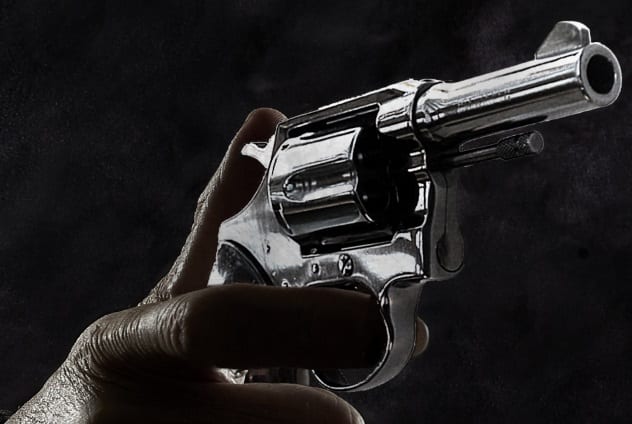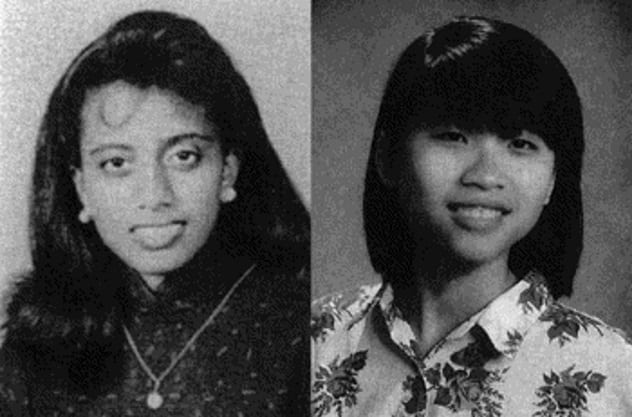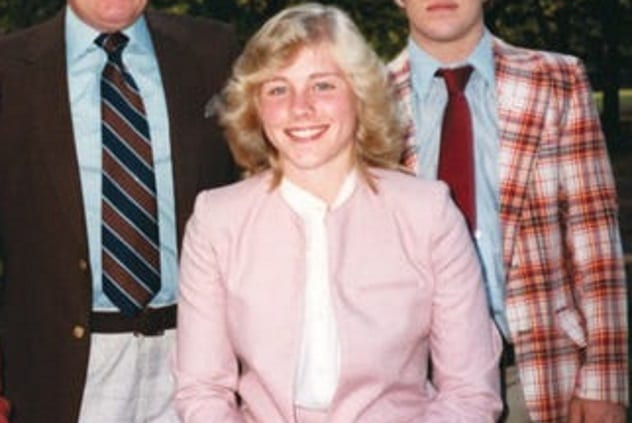 Weird Stuff
Weird Stuff  Weird Stuff
Weird Stuff  Animals
Animals 10 Inspiring Tales of Horses Being Human
 Mysteries
Mysteries Top 10 Haunting Facts About the Ghost Ship MV Alta
 History
History 10 Surprising Stories About the Texas Rangers
 Humans
Humans 10 Philosophers Who Were Driven Mad by Their Own Theories
 Miscellaneous
Miscellaneous 10 Video-Game-Worthy Weapons and Armors from History
 Weird Stuff
Weird Stuff 10 Psychics Who Accurately Predicted Wartime Events
 The Arts
The Arts 10 Pieces of Art Inspired by a Broken Heart
 Health
Health 10 Science Fiction-Sounding New Medical Treatments
 History
History 10 Surprising Facts About the Father of Submarine Warfare
 Weird Stuff
Weird Stuff 10 Times Real Laws Were Based on Bizarre Hypotheticals
 Animals
Animals 10 Inspiring Tales of Horses Being Human
 Mysteries
Mysteries Top 10 Haunting Facts About the Ghost Ship MV Alta
Who's Behind Listverse?

Jamie Frater
Head Editor
Jamie founded Listverse due to an insatiable desire to share fascinating, obscure, and bizarre facts. He has been a guest speaker on numerous national radio and television stations and is a five time published author.
More About Us History
History 10 Surprising Stories About the Texas Rangers
 Humans
Humans 10 Philosophers Who Were Driven Mad by Their Own Theories
 Miscellaneous
Miscellaneous 10 Video-Game-Worthy Weapons and Armors from History
 Weird Stuff
Weird Stuff 10 Psychics Who Accurately Predicted Wartime Events
 The Arts
The Arts 10 Pieces of Art Inspired by a Broken Heart
 Health
Health 10 Science Fiction-Sounding New Medical Treatments
 History
History 10 Surprising Facts About the Father of Submarine Warfare
10 Horrific College Dorm Murders
For millions of people throughout the world, the university dormitory is an integral part of the higher education experience. Some have fond memories of their dorm rooms; others think of their dorms as one step above a prison cell. Either way, nobody can doubt that “interesting” things tend to happen in dorm rooms.
Here, in this list, murder is highlighted. Tragically, murders have happened in dorm rooms throughout the world for decades. Roommates have been bludgeoned to death, stabbed, shot, and poisoned. Dorm roommates have been killed out of anger, out of spite, and out of jealousy. Some dormitory murders were planned well in advance; some occurred in the heat of the moment. All kinds of dorm room murders will be discussed here.
10 Double Murder At CMU

March 18, 2018, was just another day at Central Michigan University, a state school that isn’t a big name but is a big deal for the thousands who attend it. Twenty-year-old James Eric Davis Jr. looked like a lot of other undergraduates at CMU, but unlike a lot of them, James had a severe mental illness. In fact, on March 17, James had been admitted to a local hospital after he swore that unspecified people were out to kill him. Despite being taken to the hospital by police, Davis managed to escape from the hospital on foot but was caught and brought back.[10]
The next day, James’s parents arrived in Mount Pleasant, Michigan, from suburban Chicago. They planned on taking their son home for Spring Break. Therefore, James, his father James Eric Davis Sr. (a part-time police officer), and his mother Diva Jeneen Davis spent the morning of March 18 packing on the fourth floor of CMU’s Campbell Hall. At approximately 8:30 AM, James Jr. used his father’s handgun to shoot and kill both James Sr. and Diva. Following the killings, James Jr. led police on a 15-hour manhunt around CMU’s campus.
On January 25, 2019, Isabella County Trial Court Judge Eric Janes concluded that James Jr. was mentally ill during the time of the crime. At the same competency hearing, the defendant pleaded “not guilty by reason of insanity.” Eventually, James was indeed found not guilty by reason of insanity and will not face trial.
9 Professor Murderer

Back in 2005, Professor Robert Bechtel of the University of Arizona wanted to attend his 50-year class reunion in Pennsylvania. During the mid-1950s, Professor Bechtel had been a student at Swarthmore College in Swarthmore, Pennsylvania. Usually, this would not be newsworthy at all. However, Bechtel had shot and killed a fellow student in 1955, and many of his classmates were unhappy about the idea of having a killer at their class reunion.
After first telling the administration at the University of Arizona, where Bechtel had been a professor of environmental psychology since 1976, Bechtel went public with his story. In short, Bechtel blamed everything on bullying. Specifically, back in 1955, Bechtel was a 22-year-old student who had the unenviable job of being a dormitory proctor (or RA). It was his responsibility to keep students in line, and much like today, 1950s students did not take their proctors seriously. Making matters worse was the fact that the shy and bookish Bechtel had been a target of bullying since the age of four.
Bechtel decided that he’d had enough of the constant disrespect. He remembered the times when students would urinate on his bed and leave it out on the school’s quad. He also remembered all the times when students would chant, “Bechtel will eat sh–t,” as he made his rounds throughout the dorm. During the winter break of 1954–1955, Bechtel went home and purchased two firearms. His plan was to shoot the bullies and keep them permanently quiet.
That’s exactly what Bechtel did. On January 12, 1955, he shot 18-year-old Francis Holmes Strozier to death while the supposed bully slept in his dorm room. Bechtel then fired five rounds into a dorm room closet before turning himself in to the police. While in jail, Bechtel was interviewed by a psychiatrist. The psychiatrist concluded that Bechtel was “incurably insane,” and the future Arizona professor was ordered to spend the rest of his life at the Fairview State Hospital for the Criminally Insane. He would only spend five years there, and following a brief trial (where he was found not guilty by reason of insanity), Bechtel was released back into the civilian world in 1960.[2]
8 Super Crazy Boyfriend

Gregorio Orrostieta was never going to win Boyfriend of the Year. According to most accounts, Orrostieta was prone to jealousy and fits of rage. In 2015, the then-19-year-old Orrostieta was dating 18-year-old Karlie Hall. The relationship was certainly tumultuous, with Orrostieta often accusing Hall of being unfaithful.
It was not infidelity that led Orrostieta to kill Karlie on February 8, 2015. No, the thing that broke the proverbial camel’s back was a bowl of noodles. Following an argument over the spilled noodles, Orrostieta attacked Hall, a freshman at Millersville University in Lancaster, Pennsylvania, while they were both in her dorm room. When paramedics arrived on the scene, they found Orrostieta performing CPR on the lifeless Hall. It would later be determined that Hall had been dead for hours before 911 was first called.
On May 2, 2016, a jury found Orrostieta guilty of third-degree murder. Although they believed that Orrostieta had beaten and strangled Hall to death and had done so with malice, the jury also believed that the killing had not been premeditated. Judge Donald Totaro agreed with Assistant District Attorney Susan Ellison that Orrostieta’s behavior following Hall’s death, including watching rap videos on YouTube immediately following the strangulation, ignoring knocks on Hall’s dorm room door, and blaming Hall for his own actions, were indicative of a cold and callous personality.[3]
Gregorio Orrostieta was given the maximum sentence for his crime and will spend 20 to 40 years in prison.
7 A Murder And A Cover-Up

One would think that universities would feel duty-bound to inform their student body about a murder on campus. Apparently, Eastern Michigan University did not feel that way, and following the murder of EMU student Laura Dickinson, the college tried to keep everything quiet.
On December 16, 2006, Michelle Lockwood, a custodian who worked at Hill Hall, the dormitory where the 22-year-old Dickinson lived, found the young woman facedown on her bed and nude from the waist down. When investigators arrived at Room 518, they also found a pillow over Dickinson’s head and traces of semen on her leg. This semen would later be matched to another EMU student, Orange Amir Taylor III.
For ten whole weeks, EMU said nothing about this crime to either its students or to Dickinson’s parents. The horror was not brought into the light until Taylor’s arrest on February 23, 2007. The university’s failure to comply with the Clery Act would be the first controversy of the case. All told, EMU would be fined $357,000 by the US Department of Education for failing to follow federal crime reporting procedures.
The second controversy in the case revolved around tense racial issues. Despite large amounts of evidence proving that Taylor, who is black, broke into Room 518 with the intention of raping Dickinson, who was white, a mistrial was declared following a hung jury at Taylor’s first trial. Bloggers across the Internet pointed out that two of the three jurors who voted to acquit Taylor were black, while others noted that Taylor may have benefited from being physically attractive.
No such doubt was in evidence during Taylor’s second trial. During this trial, jurors listened as all the evidence was laid out against Taylor. Besides his DNA being found on Dickinson’s body, security cameras caught a man whom eyewitnesses identified as Taylor standing outside of Hill and Hoyt residence halls around 4:00 AM on the night of the murder. The same cameras caught the same man following another student into Hill Hall and walking up the stairs that led to Dickinson’s floor. Over an hour later, the cameras caught this figure leaving the hall with the very same bag that Dickinson had carried inside hours earlier.
On April 6, 2008, Orange Taylor was convicted of first-degree felony murder, assault with intent to commit sexual penetration, larceny, and first-degree home invasion. He was sentenced to life imprisonment without the possibility of parole.[4] Taylor still maintains his innocence.
6 Ice-Cold Case

At around 2:00 PM on April 26, 1993, residents at the all-female Bartlett Hall on the campus of the University of Alaska, Fairbanks, were caught off guard when a janitor came screaming out of one of the dorm’s bathrooms. Police would later learn the gruesome source of the janitor’s panic: Student Sophie Ann Sergie was in the bathroom and quite dead. It did not take an expert eye to realize that she was a homicide victim.
Sergie’s body was found on the second-floor bathroom in a semi-private room that contained a single bathtub. Sergie was found with her pants down around her ankles. She had been shot and stabbed in the face. A later autopsy would conclude that Sergie’s corpse had been in the bathtub for about 13 hours before discovery. The same autopsy also concluded that Sergie, a 20-year-old native of Pitkas Point, Alaska, had been sexually assaulted by her killer. Sergie’s cause of death was the single gunshot wound to her head, which came from a .22-caliber weapon.
Sergie and her family would have to wait more than two decades for justice. Finally, in February 2019, Steven Harris Downs, a resident of Auburn, Maine, was charged with first-degree murder after being arrested by the Maine State Police Tactical Team. For years, Alaskan investigators assumed that Sergie’s killer was either a student or someone who worked at the university. They also theorized that the killer hated women and had planned the crime beforehand.
In 2010, cold case investigators interviewed one of Downs’s former roommates and learned that he had been fired from his job as a UAF security guard after a gun, a .22-caliber revolver, was found in his possession. Downs had also been a student at UAF between 1992 and 1996. Following that, he lived in Arizona before returning to Maine. He last worked as a nurse in Auburn.
Downs, who had no arrest record prior to this year, most likely found Sergie smoking in the second-floor bathroom, which was her habit.[5] The case has yet to go to trial.
5 Harvard Goes Crimson

Ever had a bad roommate? Even if so, you’ve probably never had a roommate as bad as Sinedu Tadesse. Until 1995, though, Tadesse seemed alright. Born in Addis Ababa, Ethiopia, in 1974, Tadesse’s earliest years were marred by conflict. Specifically, Tadesse came from a well-heeled family during the hell of Ethiopia’s communist Derg dictatorship.
From 1974 until 1991, the military junta that ran the Derg engaged in political violence and abysmal economic planning that resulted in mass poverty and famine. The famine in Ethiopia during the Derg regime was so bad that millions of Americans began using starving Ethiopian children as a warning to fussy eaters. Because of their wealth, the Tadesse family were often targeted for persecution. In fact, Tadesse’s father, Zelleke Tadesse, spent two years in a Derg prison when Sinedu was a toddler.
Maybe this history inspired Sinedu to be an excellent student. Maybe not, but either way, she worked hard and eventually earned a scholarship to Harvard College, the undergraduate portion of the world-famous Harvard University. According to her father, Sinedu was happy that her best friend was also her roommate at Harvard. That best friend was Trang Ho.
Trang and Sinedu shared a lot in common: Both were very smart young women who had come to the United States as immigrants. Both had fled communist dictatorships, with Trang leaving South Vietnam with her father following North Vietnam’s takeover in 1975. Prior to landing in Massachusetts, Trang had spent a year in a violent refugee camp in Indonesia. Trang’s teachers adored her; they noted how bright and mature she was, especially since her college years coincided with her parents’ messy divorce.
Tadesse, on the other hand, floundered at Harvard. It seems that her loneliness and the rigorous demands of the school weighed her down. As a student, Tadesse earned a B average. Most would have considered this good, but Tadesse, who wanted to enroll at the Harvard Medical School, knew full well that B-average students could not make it there. In her depression, Tadesse took to looking up random names in the Cambridge phone book and began sending bizarre letters asking these people if they would be her friend.[6]
When Ho and Tadesse began rooming together in Tadesse’s sophomore year, the popular and vivacious Ho began to grow uneasy with Tadesse’s neediness. When Ho announced late in the pair’s junior year that she would be moving out, Tadesse became despondent. She began moving toward something drastic: She purchased two knives and a length of rope, got medical exemptions for two of her final exams, and had an odd lunch date with a fellow Ethiopian student. Even weirder, Tadesse sent a picture of herself to The Harvard Crimson newspaper with an attached note that read, “Keep this picture. There will soon be a juicy story involving this woman.” On May 28, 1995, Tadesse entered the Dunster House room that she shared with Ho, stabbed her to death with one of the hunting knives, stabbed one of Ho’s visiting friends, Thao Nguyen, and then hanged herself in the bathroom.
A few years later, author Melanie Thernstrom, herself a graduate of Harvard, published Halfway Heaven: Diary of a Harvard Murder. The book excoriated Harvard and its staff for not doing enough to address Tadesse’s mental health issues.
4 The Origin Of The Clery Act

Known mostly by its shorthand name the Clery Act, the Jeanne Clery Disclosure of Campus Security Policy and Campus Crime Statistics Act is a federally enforced statute that requires any institution that participates in federal financial aid programs to “maintain and disclose campus crime statistics and security information.” This act became law following the 1986 murder of college student Jeanne Clery.
Jeanne Clery was originally supposed to go to Tulane University in her hometown of New Orleans, Louisiana. However, her parents, Howard and Connie Clery, had second thoughts after they heard about the murder of Tulane sophomore Karin Minkin, an 18-year-old coed who was strangled to death at her off-campus apartment. After passing on Tulane, the family toured other colleges. Jeanne fell in love with Lehigh University, located in Bethlehem, Pennsylvania.
Sadly, Jeanne would suffer the same fate as Karin Minkin. A few days after returning to Lehigh from her Spring Break vacation, Jeanne went to a party. That night, Jeanne, 19, went to sleep in her dorm room located at Stoughton Hall. That night, 20-year-old former sophomore Josoph Henry of Newark, New Jersey, entered Stoughton Hall through three doors which had been propped open by students using pizza boxes. Henry tried several doors on the second floor but found them locked. The first door he tried on the third floor was Jeanne’s. Jeanne had left it unlocked because her roommate had left earlier that day without taking her room key.
Jeanne woke up while Josoph was in the middle of searching through her room. Josoph slashed Jeanne’s face with a beer bottle before proceeding to sodomize her. He eventually ended the young woman’s life by strangling her with a piece of wire taken from a Slinky toy.[7] After this crime, it was revealed that Josoph, a former honors student, had been thrown off campus because of his violent behavior. Plenty of people knew that Henry hated women, but he did not have an official record until 1986. Josoph Henry was originally sentenced to death, but his death sentence was thrown out in 2002. Henry eventually agreed to spend the rest of his life in prison rather than go to trial again and face the possibility of second death sentence.
The Clery family decided that their daughter’s death could have been prevented. They took Lehigh to task for poor security procedures and for failing to inform parents and students that Bethlehem’s violent crime rate had been rising for years.
3 Hear Nothing . . .

Washington, DC’s Gallaudet University is a special place. Why? Because it is one of the few federally funded universities for the deaf and hard of hearing. When two murders occurred at Gallaudet between September 2000 and February 2001, many investigators suspected a hate crime.
The first to die was 19-year-old Eric Plunkett. Plunkett, a native of Minnesota, was beaten, strangled, and hit several times with a chair on September 27, 2000. He died in his dorm room. Besides being deaf, Plunkett was also gay and the secretary of the university’s LGBT organization. When homicide investigators found that Plunkett’s message board contained anti-gay slurs and comments, they suspected that Plunkett’s killer was motivated by homophobia. Oddly enough, the first suspect they arrested in conjunction with Plunkett’s murder was a deaf and gay man.
The second Gallaudet student to die was 19-year-old Benjamin Varner of San Antonio, Texas. On February 1, 2001, Varner was stabbed 17 times in his dorm room. The person responsible for both of these crimes was Gallaudet student Joseph Mesa of Guam.
At his trial in 2002, the 22-year-old Mesa apologized to the Plunkett and Varner families. He also tried to plead insanity. District of Columbia Superior Court Judge Robert Richter did not buy this apology and sentenced Mesa to six life terms.[8] Mesa, who was born deaf, tried to convince jurors that he had carried out his crimes because he saw a pair of black gloves use sign language to tell him to kill.
2 A Bad Day At Cornell

Cornell is an Ivy League school nestled in the verdant surroundings of Ithaca, New York. It is known for its world-class engineering program. It is also known for its many suicides. In 2017, Cornell saw six suicides in six months. Suicide has been such an ongoing problem at Cornell that, back in the late 1970s, the university installed metal bars and security nets around Thurston Avenue Bridge and other bridges in order to prevent more suicides.
Arguably the most infamous suicide attempt in Cornell’s history actually began with a double homicide. In 1983, 26-year-old Su Yong Kim of Queens, New York, entered Low Rise 7 on Cornell’s North Campus. Inside the dorm was 19-year-old Young Hee Suh of Elmhurst, Queens, and 19-year-old Erin Nieswand of Long Valley, New Jersey. Kim entered the dorm late on a Saturday night and began arguing with Suh, his crush. The argument descended into chaos when Kim brandished a .22-caliber semiautomatic rifle. Kim used the weapon to take Suh, Nieswand, and five other students hostage in a single dorm room.[9] After a time, Kim let everyone else go except for Suh and Nieswand.
Kim, an obsessed lover who never got over Suh’s rejection, shot and killed Suh and Nieswand. Kim left the dorm and was chased by police for several miles. Before he could be arrested, Kim shot himself. He did not die and was transferred to the Upstate Medical Center in Syracuse, New York. Kim would eventually be convicted of second-degree murder and sentenced to 25 years in prison. Judge Betty Friedlander also recommended that Kim be deported back to his native South Korea upon his release.
The Nieswand family sued him and Cornell University for the university’s poor security standards.
1 Worst Roommate Ever

Ma Jiajue began his life in a small and impoverished village in China’s Guangxi Zhuang Autonomous Region. At age 18 in 1999, Ma ran away without telling anyone because he was depressed and afraid about the possibility of failing China’s notoriously tough National College Entrance Examination. When he was brought back to the high school, Ma tried to excuse his behavior by saying that he had run away in order to see the ocean for the first time in his life.
All of this behavior seemed silly. Ma was a gifted and successful student. Indeed, Ma managed to enter Yunnan University in the city of Kunming and, for a time, excelled as a student of biochemistry. However, this success masked Ma’s deep depression. On top of the pressure put on him by his family, who wanted Ma to lift them out of multigenerational poverty, Ma was a naturally shy and bookish student who suffered from a massive inferiority complex. Ma felt inferior to his classmates because of his poor background. At Yunnan University, Ma was just a “peasant” and not a star student.
All of these internal problems made Ma angry and prone to arguments. He had few friends at school, and Ma even shunned students who also came from poor backgrounds. Ma probably felt disrespected when wealthier students paid him money to wash their clothes. Ma was in no position to turn these offers down.
In February 2004, Ma snapped after his roommate, Shao Ruijie, accused him of cheating during a friendly card game. Shao called his friend a “misfit.” The words burned Ma’s ears and convinced him to get revenge. The next day, Ma bought plastic bags, tape, and a sledgehammer. He invited another student, Tang Xueli, to his dorm room. Here, Ma bludgeoned him to death. A day later, Ma invited Shao and Yang Kaihong over and killed them, too. His final victim, Ma’s only close friend, Gong Bo, was bludgeoned to death a day later.[10] These bodies would not be found for another eight days. In the meantime, Ma had left the university and had taken money from the bank account of one of his victims. This fact convinced Chinese police to offer a 200,000 yuan ($24,000) reward for any information that could lead to Ma’s capture.
On March 15, 2004, after spending 21 days on the run, Ma was arrested on the Chinese island of Hainan. During his trial, it was revealed that Ma was a big fan of kung fu movies and liked to spend time reading about murder cases on the Internet. On April 24, 2004, Ma was sentenced to death by a Chinese court.
Read about more disconcerting college happenings on 10 Creepy Unsolved Mysteries From College Campuses and 10 Seriously Creepy College Hauntings.





![10 Abandoned Amusement Parks With Horrific Histories [Disturbing] 10 Abandoned Amusement Parks With Horrific Histories [Disturbing]](https://listverse.com/wp-content/uploads/2019/09/gulliver-150x150.jpeg)


